| George Peter Alexander Healy | |
|---|---|
 A photograph of Healy A photograph of Healyby Southworth & Hawes | |
| Born | (1813-07-15)July 15, 1813 Boston, Massachusetts, U.S. |
| Died | June 24, 1894(1894-06-24) (aged 80) Chicago, Illinois, U.S. |
| Known for | Painting |
| Notable work | The Peacemakers Abraham Lincoln |
George Peter Alexander Healy (July 15, 1813 – June 24, 1894) was an American portrait painter. He was one of the most prolific and popular painters of his day, and his sitters included many of the eminent personages of his time. Born in Boston, he studied in Europe, and over his lifetime had studios in Paris and Chicago.
Biography

Healy was born in Boston, Massachusetts. He was the eldest of five children of an Irish captain in the merchant marine.
Having been left fatherless at a young age, Healy helped to support his mother. At sixteen years of age he began drawing, and at developed an ambition to be an artist. Jane Stuart, daughter of Gilbert Stuart, aided him, loaning him a Guido's "Ecce Homo", which he copied in color and sold to a country priest. Later, she introduced him to Thomas Sully, by whose advice Healy profited, and gratefully repaid Sully in the days of the latter's adversity.
At eighteen, Healy began painting portraits, and was soon very successful. In 1834, he went to Europe, leaving his mother well provided for, and remained abroad sixteen years during which he studied with Antoine-Jean Gros in Paris and in Rome, came under the influence of Thomas Couture, and painted assiduously. He received a third-class medal in the Paris Salon of 1840. In 1843 he was elected into the National Academy of Design as an Honorary Academician. He won a second-class medal in Paris in 1855, when he exhibited his Franklin Urging the Claims of the American Colonies Before Louis XVI.

In 1855, he returned to the United States, establishing his home and studio in Chicago, Illinois, where he remained based for the next 14 years until 1869. In 1857, he purchased a cottage in Cottage Hill, Illinois (today's Elmhurst) from Thomas Barbour Bryan, adjacent to Bryan's own Byrd's Nest estate. Healy would live in this cottage for the next six years. Bryan would be a significant patron of Healy's art. Healy also partnered with Bryan, as well as William Butler Ogden, Sidney Sawyer, and Edwin H Sheldon, in founding Graceland Cemetery. During the time his studio was based in Chicago, he also traveled in the United States to complete commissions.
Healy went back to Europe in 1869, painting steadily, chiefly in Rome and Paris, for twenty-one years. In 1892, he returned to live near family in Chicago, where he died on June 24, 1894. He was buried at Calvary Cemetery in Evanston.
Healy's autobiography, Reminiscences of a Portrait Painter, was published in 1894.
Works

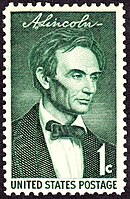
Healy was one of the most prolific and popular painters of his day. He was remarkably facile, enterprising, courageous, and industrious. "All my days are spent in my painting room" (Reminiscences). His style, essentially French, was sound, his color fine, his drawing correct and his management of light and shade excellent. His likenesses, firm in outline, solidly painted, and with later glazings, are emphatic, rugged, and forceful.
Among his portraits of eminent persons are those of Daniel Webster, Henry Clay, John Calhoun, Pope Pius IX, Arnold Henry Guyot, William H. Seward, Louis Philippe, Marshal Soult, Hawthorne, Prescott, Longfellow, Liszt, Gambetta, Thiers, Lord Lyons, Sallie Ward and the Princess (later the queen) of Romania. He painted portraits of all the presidents of the United States from John Quincy Adams to Ulysses Grant—this series being painted for the Corcoran Gallery, Washington, D.C. Healy also painted The Peacemakers in 1868 and Abraham Lincoln in 1869. In one large historical work, Webster's Reply to Hayne (1851; in Faneuil Hall, Boston), there are one hundred and thirty portraits.
His principal works include portraits of Lincoln (Corcoran Gallery), Bishop (later Cardinal) McClosky (bishop's residence, Albany), Guizot (1841, in Smithsonian Institution), Audubon (1838, Boston Soc. Nat. Hist.), Comte de Paris (Met. Mus. Of Art, New York), Isaac Thomas Hecker C.S.P., Founder of the Paulist Fathers (North American Paulist Center, Washington, D.C.)
The Newberry Library in Chicago holds 41 of Healy's paintings, donated by the artist in 1887. Most of the works can be found on display throughout the building. The Newberry also holds some letters by Healy, as well as information about the paintings.
Healy's 1877 portrait of a young Lincoln was the model used for a Lincoln postage stamp, issued on February 12, 1959, the 150th anniversary of Lincoln's birth.
Gallery
-
 Jim Bowie
Jim Bowie
-
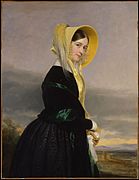 Euphemia White Van Rensselaer, 1842, MET DT2051
Euphemia White Van Rensselaer, 1842, MET DT2051
-
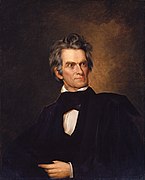 John C. Calhoun, c. 1845
John C. Calhoun, c. 1845
-
 James Knox Polk, 1846
James Knox Polk, 1846
-
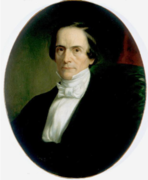 Henry Wheaton, c. 1847
Henry Wheaton, c. 1847
-
 Richard Washington Corbin, 1850
Richard Washington Corbin, 1850
-
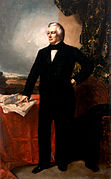 Millard Fillmore, 1857
Millard Fillmore, 1857
-
 John Quincy Adams, 1858
John Quincy Adams, 1858
-
 Martin Van Buren, 1858
Martin Van Buren, 1858
-
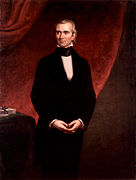 James Knox Polk, 1858
James Knox Polk, 1858
-
 Franklin Pierce, 1858
Franklin Pierce, 1858
-
 James Buchanan, 1859
James Buchanan, 1859
-
 Dr. William Grosvenor, 1859
Dr. William Grosvenor, 1859
-
 Sallie Ward, 1860
Sallie Ward, 1860
-
 Orestes A. Brownson, 1863
Orestes A. Brownson, 1863
-
 John Tyler, 1864
John Tyler, 1864
-
 William Tecumseh Sherman, 1866
William Tecumseh Sherman, 1866
-
 Eleanor Boyle Ewing Sherman, 1868
Eleanor Boyle Ewing Sherman, 1868
-
 The Peacemakers, 1868
The Peacemakers, 1868
-
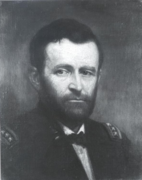 Ulysses Simpson Grant, 1868
Ulysses Simpson Grant, 1868
-
 Abraham Lincoln, 1869
Abraham Lincoln, 1869
-
 Pope Pius IX, 1871
Pope Pius IX, 1871
-
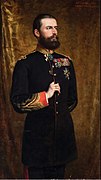 Carol I of Romania, 1873
Carol I of Romania, 1873
-
 Jennie Byrd Bryan Payne, 1874
Jennie Byrd Bryan Payne, 1874
-
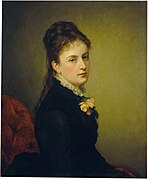 Roxana Atwater Wentworth, 1876, National Gallery of Art
Roxana Atwater Wentworth, 1876, National Gallery of Art
-
 Chester Alan Arthur, 1884
Chester Alan Arthur, 1884
-
 Self-Portrait, 1886
Self-Portrait, 1886
-
 The Wetmore Boys
The Wetmore Boys
-
 Benjamin S. Edwards
Benjamin S. Edwards
-
 Helen Edwards
Helen Edwards
-
 Ninian Wirt Edwards
Ninian Wirt Edwards
-
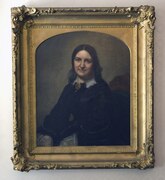 Elizabeth Todd Edwards
Elizabeth Todd Edwards
-
 Judge George Judd
Judge George Judd
-
 Lucy Judd
Lucy Judd
See also
- Arch of Titus, 1871 painting by Healy and two others
References
- ^ Hunt 1913.
- ^ Chisholm 1911.
- ^ "George Peter Alexander Healy (1813–1894)". Illinois Historical Art Project. Retrieved May 10, 2020.
- "Elmhurst". DuPage County Historical Society. September 23, 2019. Archived from the original on August 14, 2020. Retrieved May 10, 2020.
- Funigiello, Philip J. (1994). Florence Lathrop Page: A Biography. University of Virginia Press. pp. 17–18. ISBN 978-0-8139-1489-3. Retrieved May 12, 2021.
- "Visual Art | Newberry". newberry.org. Archived from the original on December 26, 2018. Retrieved December 26, 2018.
Attribution:
- [REDACTED] This article incorporates text from a publication now in the public domain: Chisholm, Hugh, ed. (1911). "Healy, George Peter Alexander". Encyclopædia Britannica. Vol. 13 (11th ed.). Cambridge University Press. p. 122.
- [REDACTED] This article incorporates text from a publication now in the public domain: Hunt, Leigh Harrison (1913). "George Peter Alexander Healy". In Herbermann, Charles (ed.). Catholic Encyclopedia. New York: Robert Appleton Company.